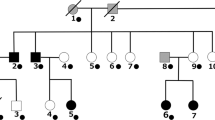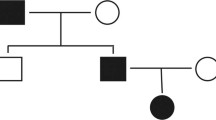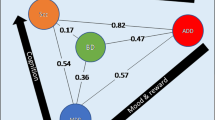Abstract
For several decades, lithium has been the drug of choice in the long-term treatment of manic-depressive illness, but the molecular mechanism(s) mediating its therapeutic effects remain to be determined. The enzyme myo-inositol monophosphatase (IMPase) in the phospholipase C signaling system is inhibited by lithium at therapeutically relevant concentrations, and is a candidate target of lithium's mood-stabilizing action. Two genes encoding human IMPases have so far been isolated, namely IMPA1 on chromosome 8q21.13–21.3 and IMPA2 on chromosome 18p11.2. Interestingly, several studies have indicated the presence of a susceptibility locus for bipolar disorder on chromosome 18p11.2. IMPA2 is therefore a candidate for genetic studies on both etiology and lithium treatment of manic-depressive illness. Here we report that the genomic structure of IMPA2 is composed of eight exons, ranging in size from 46 bp to 535 bp. the promoter region contains several sp1 elements and lacks a tata-box, features typical for housekeeping genes. by a preliminary polymorphism screening of exons 2–8 in a sample of 23 norwegian bipolar patients, we have identified nine single nucleotide polymorphisms (snps). seven of the polymorphisms were located in the introns, one was a silent transition in exon 2 (159t>c) and one was a transition in exon 5 (443g>A) resulting in a predicted amino acid substitution (R148Q). Our data show that even in a small sample of bipolar patients, several variants of the IMPA2 gene can be identified. IMPA2 is therefore an intriguing candidate gene for future association studies of manic-depressive illness.
This is a preview of subscription content, access via your institution
Access options
Subscribe to this journal
Receive 12 print issues and online access
$259.00 per year
only $21.58 per issue
Buy this article
- Purchase on Springer Link
- Instant access to full article PDF
Prices may be subject to local taxes which are calculated during checkout



Similar content being viewed by others
References
Goodwin FK, Jamison KR . Manic-depressive Illness Oxford University Press: New York 1990
Peselow ED, Fieve RR, Difiglia C, Sanfilipo MP . Lithium prophylaxis of bipolar illness. The value of combination treatment BrJ Psychiatry 1994; 164: 208–214
Maj M, Pirozzi R, Magliano L . Late non-response to lithium prophylaxis in bipolar patients: prevalence and predictors J Affect Disord 1996; 39: 39–42
Vestergaard P, Wentzer LR, Brodersen A, Rasmussen NA, Christensen H, Arngrim T et al. Outcome of lithium prophylaxis: a prospective follow-up of affective disorder patients assigned to high and low serum lithium levels Acta Psychiatr Scand 1998; 98: 310–315
Manji HK, Potter WZ, Lenox RH . Signal transduction pathways. Molecular targets for lithium's actions Arch Gen Psychiatry 1995; 52: 531–543
Lenox RH, McNamara RK, Papke RL, Manji HK . Neurobiology of lithium: an update J Clin Psychiatry 1998; 59: 37–47
Berridge MJ, Downes CP, Hanley MR . Neural and developmental actions of lithium: a unifying hypothesis Cell 1989; 59: 411–419
Allison JH, Blisner ME, Holland WH, Hipps PP, Sherman WR . Increased brain myo-inositol 1-phosphate in lithium-treated rats Biochem Biophys Res Commun 1976; 71: 664–670
Berridge MJ, Downes CP, Hanley MR . Lithium amplifies agonist-dependent phosphatidylinositol responses in brain and salivary glands Biochem J 1982; 206: 587–595
Dixon JF, Lee CH, Los GV, Hokin LE . Lithium enhances accumulation of [3H]inositol radioactivity and mass of second messenger inositol 1,4,5-trisphosphate in monkey cerebral cortex slices J Neurochem 1992; 59: 2332–2335
Kennedy ED, Challiss RA, Ragan CI, Nahorski SR . Reduced inositol polyphosphate accumulation and inositol supply induced by lithium in stimulated cerebral cortex slices Biochem J 1990; 267: 781–786
del Rio E, Shinomura T, van der Kaay J, Nicholls DG, Downes CP . Disruption by lithium of phosphoinositide signalling in cerebellar granule cells in primary culture J Neurochem 1998; 70: 1662–1669
Steen VM, Løvlie R, Osher Y, Belmaker RH, Berle J, Gulbrandsen AK . The polymorphic inositol polyphosphate 1-phosphatase gene as a candidate for pharmacogenetic prediction of lithium-responsive manic-depressive illness Pharmacogenetics 1998; 8: 259–268
Steen VM, Gulbrandsen AK, Eiken HG, Berle J . Lack of genetic variation in the coding region of the myo-inositol monophosphatase gene in lithium-treated patients with manic depressive illness Pharmacogenetics 1996; 6: 113–116
Sjøholt G, Molven A, Løvlie R, Wilcox A, Sikela JM, Steen VM . Genomic structure and chromosomal localization of a human myo-inositol monophosphatase gene (IMPA) Genomics 1997; 45: 113–122
Yoshikawa T, Turner G, Esterling LE, Sanders AR, Detera-Wadleigh SD . A novel human myo-inositol monophosphatase gene, IMP.18p, maps to a susceptibility region for bipolar disorder Mol Psychiatry 1997; 2: 393–397
York JD, Ponder JW, Majerus PW . Definition of a metal-dependent/Li(+)-inhibited phosphomonoesterase protein family based upon a conserved three-dimensional core structure Proc Natl Acad Sci USA 1995; 92: 5149–5153
Berrettini WH, Ferraro TN, Goldin LR, Weeks DE, Detera-Wadleigh S, Nurnberger JI et al. Chromosome 18 DNA markers and manic-depressive illness: evidence for a susceptibility gene Proc Natl Acad Sci USA 1994; 91: 5918–5921
Stine OC, Xu J, Koskela R, McMahon FJ, Gschwend M, Friddle C et al. Evidence for linkage of bipolar disorder to chromosome 18 with a parent-of-origin effect Am J Hum Genet 1995; 57: 1384–1394
Nöthen MM, Cichon S, Rohleder H, Hemmer S, Franzek E, Fritze J et al. Evaluation of linkage of bipolar affective disorder to chromosome 18 in a sample of 57 German families Mol Psychiatry 1999; 4: 76–84
Detera-Wadleigh SD, Badner JA, Berrettini WH, Yoshikawa T, Goldin LR, Turner G et al. A high-density genome scan detectsevidence for a bipolar-disorder susceptibility locus on 13q32 and other potential loci on 1q32 and 18p11.2 Proc Natl Acad Sci USA 1999; 96: 5604–5609
Schwab SG, Hallmayer J, Lerer B, Albus M, Borrmann M, Honig S et al. Support for a chromosome 18p locus conferring susceptibility to functional psychoses in families with schizophrenia, by association and linkage analysis Am J Hum Genet 1998; 63: 1139–1152
Shamir A, Ebstein RP, Nemanov L, Zohar A, Belmaker RH, Agam G . Inositol monophosphatase in immortalized lymphoblastoid cell lines indicates susceptibility to bipolar disorder and response to lithium therapy Mol Psychiatry 1998; 3: 481–482
Ausubel FM, Brent R, Kingston RE, Moore D, Seidman JG, Smith JA et al. Current Protocols in Molecular Biology John Wiley and Sons: New York 1996
Azizkhan JC, Jensen DE, Pierce AJ, Wade M . Transcription from TATA-less promoters: dihydrofolate reductase as a model Crit Rev Eukaryot Gene Expr 1993; 3: 229–254
Schuller HJ, Richter K, Hoffmann B, Ebbert R, Schweizer E . DNA binding site of the yeast heteromeric Ino2p/Ino4p basic helix-loop-helix transcription factor: structural requirements as defined by saturation mutagenesis FEBS Lett 1995; 370: 149–152
Van Dijken P, Bergsma JC, Hiemstra HS, De Vries B, Van Der Kaay J, Van Haastert PJ . Dictyostelium discoideum contains three inositol monophosphatase activities with different substrate specificities and sensitivities to lithium Biochem J 1996; 314: 491–495
Gillaspy GE, Keddie JS, Oda K, Gruissem W . Plant inositol monophosphatase is a lithium-sensitive enzyme encoded by a multigene family Plant Cell 1995; 7: 2175–2185
Antonarakis SE . Recommendations for a nomenclature system for human gene mutations. Nomenclature Working Group Hum Mutat 1998; 11: 1–3
Acknowledgements
This study has been supported by Dr Einar Martens’ Research Fund, the Research Council of Norway (Mental Health Program) and in part by Eva Torhild's Memorial Fund for Medical Research.
Author information
Authors and Affiliations
Corresponding author
Rights and permissions
About this article
Cite this article
Sjøholt, G., Gulbrandsen, A., Løvlie, R. et al. A human myo-inositol monophosphatase gene (IMPA2) localized in a putative susceptibility region for bipolar disorder on chromosome 18p11.2: genomic structure and polymorphism screening in manic-depressive patients. Mol Psychiatry 5, 172–180 (2000). https://doi.org/10.1038/sj.mp.4000681
Received:
Revised:
Accepted:
Published:
Issue Date:
DOI: https://doi.org/10.1038/sj.mp.4000681
Keywords
This article is cited by
-
A new locus regulating MICALL2 expression was identified for association with executive inhibition in children with attention deficit hyperactivity disorder
Molecular Psychiatry (2018)
-
IP3 accumulation and/or inositol depletion: two downstream lithium’s effects that may mediate its behavioral and cellular changes
Translational Psychiatry (2016)
-
Identification of genomic locus responsible for experimentally induced testicular teratoma 1 (ett1) on mouse Chr 18
Mammalian Genome (2014)
-
IMPA1 is Essential for Embryonic Development and Lithium-Like Pilocarpine Sensitivity
Neuropsychopharmacology (2008)
-
Barley (Hordeum vulgare L.) inositol monophosphatase: gene structure and enzyme characteristics
Plant Molecular Biology (2008)



